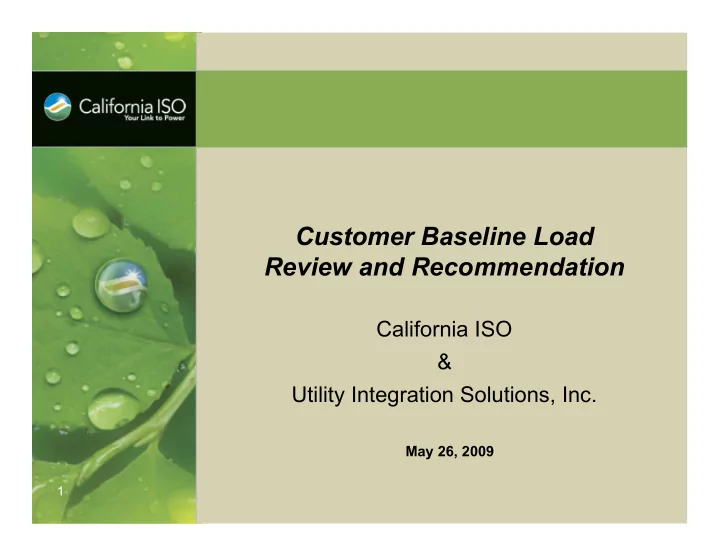

Customer Baseline Load Review and Recommendation California ISO & Utility Integration Solutions, Inc. May 26, 2009 1
References 2008 Load Impact Evaluation of California Statewide Aggregator Demand Response Programs Volume 2: Baseline Analysis of AMP Aggregator Demand Response Program by Christensen Associates Energy Consulting, LLC (May 1, 2009) Evaluating Baselines for Demand Response Programs 2008 AEIC Load Research Workshop by Clifford Grimm, DTE Energy (February 25, 2008) Estimating Demand Response Load Impacts: Evaluation of Baseline Load Models for Non-residential buildings in California, Berkeley Lab, January 2008 Various ISO-NE, NYISO, and PJM documents Slide 2
Common Analysis Findings There is no single CBL method that fits all needs Several methods work reasonably well in most cases Adjusted baselines are usually better than non-adjusted Highly variable loads are most difficult to predict Slide 3
Approach Identify core CBL methodology Establish processes for: Submitting variations to CBL Submitting alternative CBL methods Slide 4
Baseline Fundamentals X days out of Y days (e.g. 4 of 5, 3 of 10, 10 of 10) Typically discard some number of high and/or low days Number of day types Only consider day types that are similar to event day 2 day types = Weekdays, Weekends+Holidays 5 day types = Mon, Tues-Thur, Fri, Sat, Sun+Holidays Lookback window 30, 45, 60 days? Need a larger window when a larger sample is required, or more day types are used. Constant or variable? Some markets have rules for allowing the lookback window to grow on certain conditions 5
Baseline Fundamentals (cont) Threshold Exclude abnormally high and/or low days (e.g. <25%) Prior event days Exclude prior event days, unless there are an insufficient number of normal load days in the lookback window Load point adjustment (morning adjustment) Method of adjusting the calculated baseline by using the morning hours prior to the event to normalize Weather sensitive adjustment Method of adjusting the calculated baseline by using weather data and resource-specific weather sensitivity regression factors 6
Determine Baseline 25 DAY 1 DAY 2 DAY 3 DAY 4 20 DAY 5 BASELINE 15 Demand [kW] 10 5 0 1 2 3 4 5 6 7 8 9 10 11 12 13 14 15 16 17 18 19 20 21 22 23 24 Hour Ending
Examine Demand Response Event Stages 25 EVENT DAY DEMAND DEPLOYMENT BASELINE 20 NORMAL OPERATIONS 15 Demand [kW] REDUCTION 10 DEADLINE RELEASE / RECALL 5 0 1 2 3 4 5 6 7 8 9 10 11 12 13 14 15 16 17 18 19 20 21 22 23 24 Hour Ending
Apply “Morning Adjustment” 25 EVENT DAY DEMAND EVENT EVENT BEGINS BASELINE ENDS ADJUSTED BASELINE 20 15 Demand [kW] 10 5 MORNING ADJUSTMENT WINDOW 0 1 2 3 4 5 6 7 8 9 10 11 12 13 14 15 16 17 18 19 20 21 22 23 24 Hour Ending
Calculate Demand Reduction 25 CALCULATED REDUCTION EVENT DAY DEMAND 20 15 Demand [kW] 10 5 0 1 2 3 4 5 6 7 8 9 10 11 12 13 14 15 16 17 18 19 20 21 22 23 24 Hour Ending
Slide 11 PJM Analysis
Berkeley Lab Analysis Slide 12
Slide 13 Berkeley Lab Analysis
Christensen Findings Slide 14
Other Baselines ISO-NE Rolling baseline calculation “Customer/Resource Specific” Historical model Meter before/Meter after Metered generation Statistical estimates Slide 15
Possible CBL Methods Customer/Resource specific is overhead/data intensive Rolling baseline method at ISO-NE appears to be somewhat new CA Aggregator and PJM methods have been heavily studied 4 of 5 method at PJM is complex Multiple day types, variable lookback window, load thresholds, prior event exclusion rules, load point adjustments 10 in 10 method has familiarity in CA market Slide 16
CAISO Proposal Start with 10 in 10 CBL method No elimination of abnormally low days Lookback window of 45 days No window extensions Like days are M-F exclusive of weekends/holidays Is a variation necessary for weekends/holidays - e.g. 5 of 5? Use highest event days if 10 like days cannot be found Load point adjustment as default Weather adjustment requires resource specific sensitivity factors, and misses other secular effects Slide 17
Apply “Morning Adjustment” 25 EVENT DAY DEMAND EVENT EVENT BEGINS BASELINE ENDS ADJUSTED BASELINE 20 15 Demand [kW] 10 5 MORNING ADJUSTMENT WINDOW 0 1 2 3 4 5 6 7 8 9 10 11 12 13 14 15 16 17 18 19 20 21 22 23 24 Hour Ending
“Morning Adjustment” Alternatives X = Average Load on event day for 3 hours prior to event Skip the hour immediately before the event? Y = Average Load of baseline for same 3 hours Multiplicative adjustment Ratio is X / Y Adjusted baseline = Each hour of baseline event load * (X / Y) Adjustments to be capped at +/- 20% Alternative - Additive adjustment (used by PJM, ISONE) Difference is X – Y Adjusted baseline = Each hour of baseline event load + (X – Y) Slide 19
Recommend
More recommend